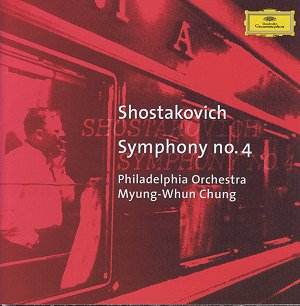Shostakovich's Fourth Symphony is an extraordinary
work by any standards. It is cast in three movements, with each of the
outer two approaching half an hour in duration, astride a shorter central
scherzo. Together these occupy a playing time in excess of an hour.
There is a huge orchestra, of some 140 players, so the range of timbres
and colours is very wide indeed, and the climaxes are overwhelmingly
powerful. But more significant than any of these issues is the nature
of the music itself, since the development is flexible and remarkably
open-ended, veering this way and that, through passages slow and fast,
thinly scored and richly powerful. It is a roller-coaster ride for both
the musicians and the audience.
No wonder the Symphony has enjoyed a chequered career.
Shostakovich withdrew it in 1936, when it was already in rehearsal for
its first performance. This decision had more to do with the attack
on him by Stalin in the pages of Pravda than with musical problems during
the rehearsal period. For after Stalin had launched his vitriolic feelings
- 'Not music but a mess' - about the opera Lady Macbeth of Mtsensk,
the composer knew he was a marked man. And a challenging, modernist
symphony was not a wise proposition. So the Fourth did not receive its
premiere until 1961, a full 25 years after it was written, and Shostakovich
achieved a rehabilitation with his Fifth Symphony of 1937: 'A Soviet
Artist's Response to Just Criticism'. (Of course the nature of the Fifth
and whether that title is a decoy is another matter altogether.)
The Fourth Symphony has fared rather well as far as
recordings are concerned. Any live performance has to be a special occasion
because of the costs involved in assembling such a large orchestra,
and perhaps that is why live performances have often been linked with
recordings. In this, his first purely orchestral symphony for ten years,
Shostakovich wrote the music he wanted to write. The style follows that
of the opera Lady Macbeth of Mtsensk and the ballet The Bolt,
and is therefore expressively potent and orchestrally colourful. The
very opening confirms all this, and immediately throws down the gauntlet
to the recording engineers, with the huge percussive chord that follows
the opening phrase. The DG recording is spectacular and meets every
requirement: it is sensitive to detail and has a full and accurate dynamic
range. In fact it is the best thing about the whole enterprise.
The challenges in performing this music are twofold:
the orchestra must reach heights of discipline and virtuosity, and the
conductor must hold the music in a vision of symphonic continuum and
growth. This performance fares better on the first of these points,
I feel, than on the second. For the Philadelphia Orchestra plays magnificently,
both as individuals and as a team. Myung-Whun Chung is an artist of
the front rank, with an acclaimed recording of Lady Macbeth to
his credit. However, I am not entirely convinced by his interpretation
of the Symphony.
Listen to any part of the work as a demonstration-quality
excerpt and it will sound pretty impressive. But there is more symphonic
strength in the score than Chung finds here. Several times his choice
of phrasing misses the mark by dashing ahead with too little concern
for articulation, and the inner relationships of the parts do not build
up their subtle significances. Of course these things are to some extent
a matter of how the individual listener who knows the music feels that
it should sound. And any great symphony is greater than any one performance
of it. But for this listener at least, Chung does not pass the acid
test, that in performance the music sounds as if it could not possibly
be performed otherwise.
That said, there are some aspects which are spectacularly
effective. The first movement's fast string fugue at tempo Presto, for
example, is an amazing feat of virtuosity, while the central movement
is nicely atmospheric, particularly the diminuendo during the closing
phase. The final powerful climax is hugely sonorous, and has probably
never sounded better on disc. Therefore the tragic descent towards the
dark coda makes its impression too.
Quite why the performance was recorded eight years
ago and only released now we do not know. It is well worth hearing,
but then so too are many other performances of this remarkable work,
including for example those by Simon Rattle, Mstislav Rostropovich,
Kirill Kondrashin, Neeme Järvi, and by the same Philadelphia Orchestra
with Eugene Ormandy conducting. For all its strange, even bizarre characteristics,
the Fourth is perhaps Shostakovich's greatest symphony. In truth, the
best performance of it should always be 'the next one'.
Terry Barfoot


